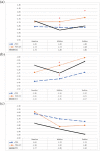Evaluation of mobile phone-based Positive Deviance/Hearth child undernutrition program in Cambodia
- PMID: 34414653
- PMCID: PMC8476410
- DOI: 10.1111/mcn.13224
Evaluation of mobile phone-based Positive Deviance/Hearth child undernutrition program in Cambodia
Abstract
Child undernutrition in Cambodia is a persistent public health problem requiring low-cost and scalable solutions. Rising cellphone use in low-resource settings represents an opportunity to replace in-person counselling visits with phone calls; however, questions remain on relative effectiveness. Our objective was to evaluate the impact of two options for delivering a World Vision infant and young child feeding (IYCF) counselling programme: (1) traditional Positive Deviance/Hearth (PDH) programme with in-person visits or (2) PDH with Interactive Voice Calling (PDH-IVC) which integrates phone calls to replace 62.5% of face-to-face interaction between caregivers and volunteers, compared to the standard of care (SOC). We conducted a longitudinal cluster-randomised controlled trial in 361 children 6-23 months. We used an adjusted difference-in-difference approach using baseline, midline (3 months) and endline (12 months) surveys to evaluate the impact on child growth among the three groups. At baseline, nearly a third of children were underweight, and over half were food insecure. At midline the PDH group and the PDH-IVC groups had improved weight-for-age z-scores (0.13 DID, p = 0.011; 0.13 DID, p = 0.02, respectively) and weight-for-height z-score (0.16 DID, p = 0.038; 0.24 DID, p = 0.002), relative to SOC. There were no differences in child height-for-age z-scores. At endline, the impact was sustained only in the PDH-IVC group for weight-for-age z-score (0.14 DID, p = 0.049), and the prevalence of underweight declined by 12.8 percentage points (p = 0.036), relative to SOC. Integration of phone-based IYCF counselling is a potentially promising solution to reduce the burden of in-person visits; however, the modest improvements suggest the need to combine it with other strategies to improve child nutrition.
Keywords: Cambodia; Positive Deviance/Hearth programme; children; underweight.
© 2021 World Vision International. Maternal & Child Nutrition published by John Wiley & Sons Ltd.
Conflict of interest statement
The authors declare that they have no conflicts of interest.
Figures


Similar articles
-
Program Impact Pathway of the Positive Deviance/Hearth Interactive Voice Calling Program in a Peri-Urban Context of Cambodia.Curr Dev Nutr. 2022 Mar 28;6(5):nzac045. doi: 10.1093/cdn/nzac045. eCollection 2022 May. Curr Dev Nutr. 2022. PMID: 35611354 Free PMC article.
-
Shonjibon cash and counselling: a community-based cluster randomised controlled trial to measure the effectiveness of unconditional cash transfers and mobile behaviour change communications to reduce child undernutrition in rural Bangladesh.BMC Public Health. 2020 Nov 25;20(1):1776. doi: 10.1186/s12889-020-09780-5. BMC Public Health. 2020. PMID: 33238946 Free PMC article. Clinical Trial.
-
Nutrition education linked to agricultural interventions improved child dietary diversity in rural Cambodia.Br J Nutr. 2016 Oct;116(8):1457-1468. doi: 10.1017/S0007114516003433. Epub 2016 Oct 5. Br J Nutr. 2016. PMID: 27702425 Free PMC article. Clinical Trial.
-
Determinants of Child Malnutrition and Infant and Young Child Feeding Approaches in Cambodia.World Rev Nutr Diet. 2016;115:61-7. doi: 10.1159/000444609. Epub 2016 May 19. World Rev Nutr Diet. 2016. PMID: 27197522 Review.
-
Nutrition: basis for healthy children and mothers in Bangladesh.J Health Popul Nutr. 2008 Sep;26(3):325-39. doi: 10.3329/jhpn.v26i3.1899. J Health Popul Nutr. 2008. PMID: 18831228 Free PMC article. Review.
Cited by
-
Effectiveness of a positive deviance approach to improve mother's nutritional knowledge, attitude, self-efficacy, and child's nutritional status in Maji District, West Omo Zone, South West region, Ethiopia: a cluster randomized control trial.Front Public Health. 2023 Nov 13;11:1277471. doi: 10.3389/fpubh.2023.1277471. eCollection 2023. Front Public Health. 2023. PMID: 38026394 Free PMC article. Clinical Trial.
-
The use of positive deviance approach to improve health service delivery and quality of care: a scoping review.BMC Health Serv Res. 2024 Apr 8;24(1):438. doi: 10.1186/s12913-024-10850-2. BMC Health Serv Res. 2024. PMID: 38589897 Free PMC article.
-
Maternal media exposure and child anthropometric failures across 40 low- and middle-income countries.SSM Popul Health. 2024 Dec 31;29:101746. doi: 10.1016/j.ssmph.2024.101746. eCollection 2025 Mar. SSM Popul Health. 2024. PMID: 39906335 Free PMC article.
-
Effectiveness of Positive Deviance Approach to Reduce Malnutrition among under Five Children: A Systematic Review and Meta-Analysis of Interventional Studies.Nutrients. 2023 Apr 19;15(8):1961. doi: 10.3390/nu15081961. Nutrients. 2023. PMID: 37111180 Free PMC article.
-
Program Impact Pathway of the Positive Deviance/Hearth Interactive Voice Calling Program in a Peri-Urban Context of Cambodia.Curr Dev Nutr. 2022 Mar 28;6(5):nzac045. doi: 10.1093/cdn/nzac045. eCollection 2022 May. Curr Dev Nutr. 2022. PMID: 35611354 Free PMC article.
References
-
- Bhatt, S. (2017). Using Mobile Technology for Nutrition Programs. Sight and Life, 31(2). https://sightandlife.org/wp‐content/uploads/2017/12/SALmagazine_Technolo...
-
- Bhutta, Z. A., Das, J. K., Rizvi, A., Gaffey, M. F., Walker, N., Horton, S., Webb, P., Lartey, A., Black, R. E., & Child Nutrition Study, G . (2013). Evidence‐based interventions for improvement of maternal and child nutrition: What can be done and at what cost? Lancet, 382(9890), 452–477. 10.1016/S0140-6736(13)60996-4 - DOI - PubMed
-
- CARD, UNICEF. World Food . (2013). The economic consequences of malnutrition in Cambodia: A damage assessment report. Retrieved from https://cdn.wfp.org/wfp.org/publications/Report%20on%20Economic%20Conseq...
-
- CDHS . (2015). Demographic and health Survey 2014. Retrieved from Phnom Penh, Cambodia, and Rockville, Maryland, USA.
Publication types
MeSH terms
Associated data
LinkOut - more resources
Full Text Sources
Medical

